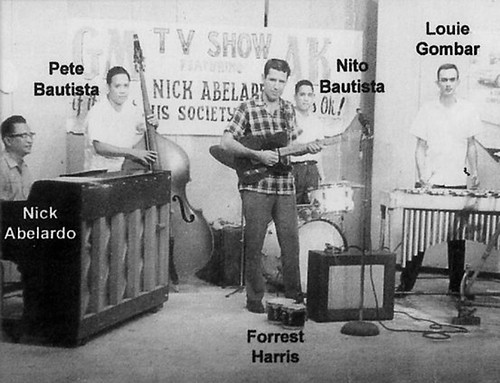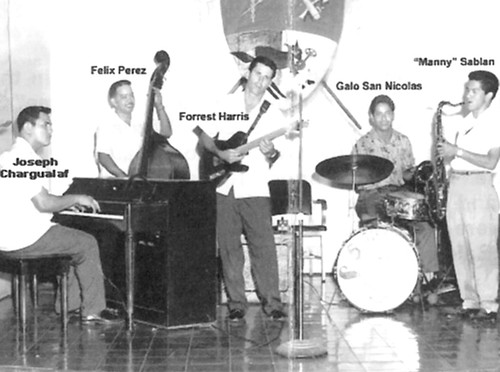Forrest Harris
A life long musician
Forrest Harris (1932 – ) first found his interest in music at nine years old while strumming a ukulele and playing a country song called “San Antonio Rose.” He would go on in his adult years to playing the mandolin, although he preferred the sound of the guitar. With some ingenuity, he altered the strings on his mandolin so that it sounded and played like a guitar. After World War II Harris began playing music with the Sånta Rita-Sumai Band with six other band members. This was the first organized group with which Harris played.
Forrest Harris was born to an American solider, Arthur Harris, and his CHamoru wife Dolores Sablan Mendiola, daughter of Ana Diaz Sablan and Nicholas Cruz Mendiola. In 1936, the Harris family relocated to Guam with their children Betty and Forrest. The youngest child, Dean, was born on Guam just before the World War II broke out. When Arthur was called to duty, he managed to get his daughter, Betty, off Guam, but was forced to leave his wife and sons behind.
As the wife of an American with two light- complected children, Dolores was often singled out for interrogation.
The aunties often scraped meat off the skins of leftover sweet potatoes, mixed it with flour and made donuts to present to the Japanese soldiers in exchange for biscuits or cigarettes. When the uncles got together, they drank tuba and sang.
Oh my god! I used to scold my uncles. When they’re already drunk, that’s when they begin to sing! Oh, Uncle Sam, my dear Uncle Sam, won’t you please come back to Guam! I can remember how they would sing it. And you won’t believe their love of the country, how loyal they were.
These moments of joy were as risky as they were short-lived. When the Americans bombed Hagåtña, Forrest and his Aunt Consolation hid in the basement of their home. Between the sound of shells crashing into the town above, Forrest remembers Aunt Consolation whispering the rosary, over and over. When they emerged three hours later, the village was reduced to a field of matchsticks.
Toward the end of the war, the Japanese soldiers rounded up many CHamorus into the Manenggon concentration camp. Everyone carried what they could – food, clothes, even the mañamko. Harris’s Grandma Ana was put onto a makeshift stretcher and carried on the shoulders of two uncles.
No place for music at Manenggon
There was no music then. There was no time for that. During the occupation, it was all survival. Especially the Manenggon. You can’t cook. You can’t start a fire. Everything has to be raw. I would go miles and miles to find whatever was eatable.
If caught by Japanese soldiers, he would have been put to work or killed on the spot. But there were worse things than that, Forrest would find. Beginning 21 July 1944, the second Battle of Guam lasted nearly three weeks, leaving thousands dead and wounded. That is what Forrest remembers most of all. He remembers American soldiers hammering dog tags between the teeth of corpses, and the chain hanging down their chin, as they were wrapped in rubber bags.
Became a CHamoru Navy steward
After the war, Forrest started playing music again, joining the six-piece band the Santa Rita Boys. When his father never returned to Guam, Forrest resolved to find him. At 16, he lied about his age and enlisted in the US Navy, so he could see the world.
But nobody warned him that the only job for CHamoru recruits was that of a steward.
You did everything except jump into bed with the officers.
He did laundry, cooked, cleaned, made beds, and served food. The Korean War broke out in 1950, and Forrest was told to pack his bags. While he thought he was finally going off to boot camp, he was instead brought to the USS Uvadle cargo ship, and sent straight to Korea. When they saw him boarding, however, the sailors cheered, because Forrest was always playing guitar after work and they hoped he would entertain them on the voyage.
Delayed, but undeterred, Forrest finally made it to the mainland United States, and found his father – only to find Arthur Harris had moved on, believing his wife and children were killed during the war.
I just could not believe he would look me straight in the eye and say, ‘I was informed by the War Department that you were all killed.’ You know, I was just 17 years old and I said my God, I can’t believe what I’m hearing.
During his time with the Navy, Harris became exposed to many jazz musicians in the US and elsewhere abroad. During his military stint, he frequented places that featured jazz music and even attended a jazz workshop held by the late guitar great, Barney Kessel. Harris attributes much of his learning to these experiences including having the opportunity to watch various bands perform on USO tours alongside the late Bob Hope. Harris saw several groups perform, including Woody Herman’s Big Band, Lionel Hampton, and Billy Eckstein.
Aside from his experiences abroad with famous musicians, Harris was greatly inspired by his close friend, Jesus Santos, because of Santos’s extraordinary talent and the dexterity with which he played the guitar. Santos is remembered for being able to play chords on the guitar while playing the melody simultaneously, fulfilling the duties of a lead guitarist and rhythm guitarist at the same time.
Back to Guam
In Hawai`i, Forrest Harris met his wife Lillian Isobe, a survivor of Pearl Harbor. The couple raised four children in Hågat, Philip Raymond, Kim, Dean Arthur, and Betty, named after his favorite Aunt Beatrice.
When Forrest returned to Guam, he put his energy into his music, famously playing with the Five Locals. Performing at Talk O’ the Town, the Breakers Club, The Office, and Jim’s Island House, the band became an important part of young lovers’ lives.
One thing I would like to add. I think I hooked up a lot of couples with the band. Because I grew up with a lot of them, and they would come see the band and they would be all lovey dovey, and the next thing I know, they’re inviting us to play for the wedding. So in a way, I take responsibility for that.
To this day, Forrest continues to gig, chording and picking his guitar.
You know what, maybe that’s what kept me sane. Really, maybe that’s what it is, my love for music.
Harris is known for holding a high degree of respect for fellow musicians and for maintaining high standards of professionalism on the stage, never resorting to “on-stage chastising” of less experienced musicians who happen to err during performances.
Harris has been, and still is, regarded by local musicians as an accomplished and talented lead guitarist. He is greatly admired and respected not only by fellow musicians, past and present, but by music enthusiasts as well.
Editor’s note: The photos and initial research for this entry is courtesy of Mico and Stevie Scott’s Jazz on Guam: An Oral History, a project funded by the Guam Humanities Council and in part by the National Endowment for the Humanities. The account of his war years was written by Amanda Pampuro, reprinted and adapted, with permission, from Guam War Survivors Memorial Foundation.



